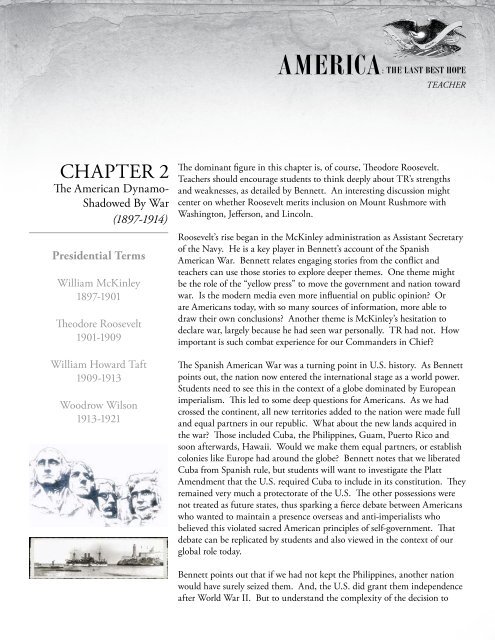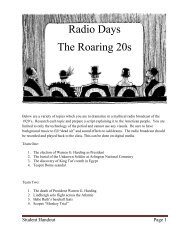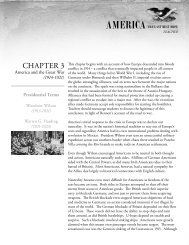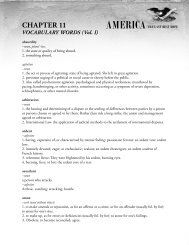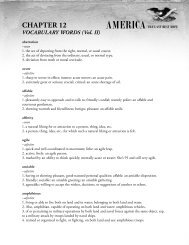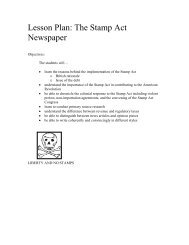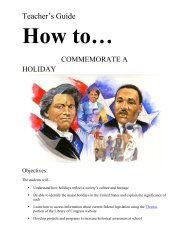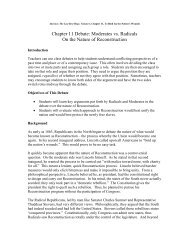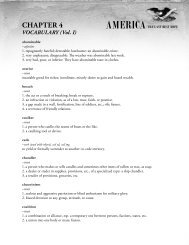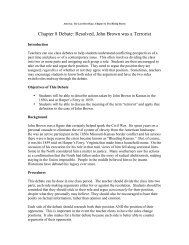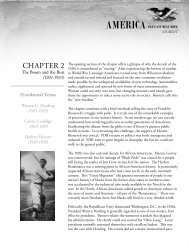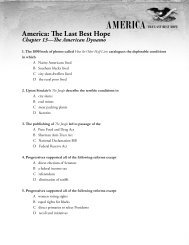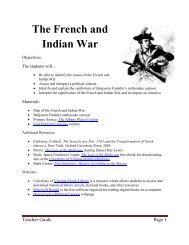Chapter 2 Teacher Summary - Last Best Hope
Chapter 2 Teacher Summary - Last Best Hope
Chapter 2 Teacher Summary - Last Best Hope
Create successful ePaper yourself
Turn your PDF publications into a flip-book with our unique Google optimized e-Paper software.
AMERICA: THE LAST BEST HOPETEACHERCHAPTER 2The American Dynamo-Shadowed By War(1897-1914)Presidential TermsWilliam McKinley1897-1901Theodore Roosevelt1901-1909William Howard Taft1909-1913Woodrow Wilson1913-1921The dominant figure in this chapter is, of course, Theodore Roosevelt.<strong>Teacher</strong>s should encourage students to think deeply about TR’s strengthsand weaknesses, as detailed by Bennett. An interesting discussion mightcenter on whether Roosevelt merits inclusion on Mount Rushmore withWashington, Jefferson, and Lincoln.Roosevelt’s rise began in the McKinley administration as Assistant Secretaryof the Navy. He is a key player in Bennett’s account of the SpanishAmerican War. Bennett relates engaging stories from the conflict andteachers can use those stories to explore deeper themes. One theme mightbe the role of the “yellow press” to move the government and nation towardwar. Is the modern media even more influential on public opinion? Orare Americans today, with so many sources of information, more able todraw their own conclusions? Another theme is McKinley’s hesitation todeclare war, largely because he had seen war personally. TR had not. Howimportant is such combat experience for our Commanders in Chief?The Spanish American War was a turning point in U.S. history. As Bennettpoints out, the nation now entered the international stage as a world power.Students need to see this in the context of a globe dominated by Europeanimperialism. This led to some deep questions for Americans. As we hadcrossed the continent, all new territories added to the nation were made fulland equal partners in our republic. What about the new lands acquired inthe war? Those included Cuba, the Philippines, Guam, Puerto Rico andsoon afterwards, Hawaii. Would we make them equal partners, or establishcolonies like Europe had around the globe? Bennett notes that we liberatedCuba from Spanish rule, but students will want to investigate the PlattAmendment that the U.S. required Cuba to include in its constitution. Theyremained very much a protectorate of the U.S. The other possessions werenot treated as future states, thus sparking a fierce debate between Americanswho wanted to maintain a presence overseas and anti-imperialists whobelieved this violated sacred American principles of self-government. Thatdebate can be replicated by students and also viewed in the context of ourglobal role today.Bennett points out that if we had not kept the Philippines, another nationwould have surely seized them. And, the U.S. did grant them independenceafter World War II. But to understand the complexity of the decision to
AMERICA: THE LAST BEST HOPETEACHERkeep them in 1898, students need to be reminded that the Filipinos hadbeen fighting for their independence against Spain before the war. Bennettmentions that Emilio Aguinaldo led Filipino fighters in an uprising againstU.S. rule. This American-Filipino conflict took three years for Americantroops to put down and cost an estimated 10,000 U.S. casualties. But thiswar that was longer and much more costly than the Spanish American Waris only briefly mentioned in this, and almost any other work on Americanhistory. Students might explore the tendency of all nations to remembertheir own stories in certain ways using this as an illustration.Photo 1: Booker T. Washington andTheodore RooseveltTR’s rapid rise from war hero to governor, to vice-president and then topresident upon McKinley’s assassination is remarkable. He is the youngestperson ever to serve as our chief executive. Students need to see Roosevelt’srise in the midst of the Progressive Era, a time when Americans from allwalks of life were looking for ways to address difficult political, social, andeconomic conditions brought on by the dramatic rise of industrialism andurbanism. Such conditions were highlighted by great writers of the day– people TR labeled “muckrakers.” Students would benefit from readingselections of the works of Jacob Riis, Upton Sinclair, Lincoln Steffens,Ida Tarbell, and others. Roosevelt certainly took progressive actions aspresident in the areas of conservation, railroad regulation (the Elkins Act),trust litigation (the Northern Securities Company case), and the protectionof consumers from tainted food and medicine (the Pure Food and DrugAct). The debate Americans had then about the proper role of governmentin a free market continues to this day. It tends to be what separates liberalsfrom conservatives. <strong>Teacher</strong>s can easily compare the debates over progressivereforms then with debates over government programs and policies today.Americans largely accept a role for government in our lives, but how muchgovernmental involvement is too much?Another fascinating moment involving TR related by Bennett is the storyof the president inviting Booker T. Washington to the White House fordinner. In earlier chapters students read of the tragic implementation ofJim Crow laws in the South. Bennett also relates the shocking patterns oflynching that took place in the region. And Plessy v. Ferguson was the lawof the land, with the Supreme Court accepting segregation as legitimateand just social policy. Students need to see Washington’s invitation inthis context. Bennett goes on to relate the conflict between Washingtonand his contemporary rival, W.E.B. DuBois. Students would benefit fromresearching the biographies of these two leaders. Do their different lifestories account for their very different approaches to seeking full civil rightsfor African-Americans? Whose leadership was more relevant for African-Americans at that time?
AMERICA: THE LAST BEST HOPETEACHERPhoto 2: The Great Titanic Disaster(Library of Congress)Roosevelt’s foreign policy should also lead to excellent class discussion.Bennett details the story of the acquisition of the Panama Canal Zone in away that leaves the reader torn about the justice of TR’s actions. Would thecanal have been built without his “big stick?” Did Colombia have legitimategrievances over this episode? Is TR to be admired for this action? If not,are we unfairly applying our own standards of justice to that time? Thebuilding of the canal itself was an extraordinary feat of engineering studentsmight explore more deeply. And the history of this incident is critical for adiscussion of the decision of the United States in 1977 to sign a treaty givingPanamanians control of the canal in 2000. This caused a fierce debate in the1970s. Was the treaty a good foreign policy decision? And the “RooseveltCorollary” also impacted U.S. relations with Latin America. Students candiscuss if it was indeed a legitimate extension of the Monroe Doctrine.Bennett calls the William Howard Taft administration an “interlude”between two notable presidents. Students might evaluate whether Taftdeserves more recognition in our memory. Bennett points out that Taftactually “busted” more trusts than did the original “trust buster” himself.Why then, do we hold TR in such higher regard?At this point of the narrative, Bennett tells the story of the Titanic. Studentslikely know this story well, but will certainly find its retelling captivating.Besides the human drama, Bennett puts his account in the context of theProgressive Era, a time in which reformers attacked the colossal fortunesof a few corporate giants, which they argued were gained at the expense ofthe working masses. Students will see how stories coming from the tragedyreinforced these perceptions of class and injustice.Divisions within the Republican Party and disputes between TR and Taftled to an attempt of the former president to replace his old friend and regainpower. The election of 1912 was one of the most dramatic in our history andformer allies became bitter enemies. Taft, Roosevelt, and Wilson all claimedto be true progressives. Republican Taft ran on his record of reform, TRcalled for more government action in his “New Nationalism” and with hisProgressive (Bull Moose) Party, and Democrat Woodrow Wilson called fora “New Freedom.” Students will find it fascinating that a Socialist Partycandidate (Eugene V. Debs) garnered over a million votes. What does thatsay about the challenging conditions facing workers in America at thattime? With the Republicans split between Taft and TR, Wilson won thepresidency. Bennett argues that a strong third party candidate led to theelection of a president who only a minority of Americans supported. Doesthis make the definitive case for a two-party system?
AMERICA: THE LAST BEST HOPETEACHERWilson’s New Freedom program did take progressive reforms to new levels.The Federal Reserve System still plays a key role in our economy, onethat students can explore. The Underwood Tariff lowered rates that haddamaged U.S. trade. And the Clayton Anti-Trust Act corrected featuresof the Sherman Act that had been used against unions. Bennett quotesSamuel Gompers as calling this act a “charter of freedom” for workers.Students should consider how critical the right to strike and picket has beenfor workers struggling for higher wages and humane working conditions.But Wilson, who was a southerner, is also remembered for his praise of theclearly racist film Birth of a Nation, and for reintroducing segregation to thefederal work force in Washington D.C. These incidents remind studentsthat even progressive idealists of the period were sometimes hampered by theprevailing prejudices that existed not just in the South, but also across thenation.This chapter concludes with incidents in distant Europe that would spiralinto a world conflict. Entangling alliances caused the “powder keg” that wasthe Balkans to erupt in a war that Americans initially believed was not theirconcern. But as seen earlier in the chapter, America was by 1914 a worldpower in its own right. As much as they might hope otherwise, Americansin uniform would ultimately end up “over there.”


